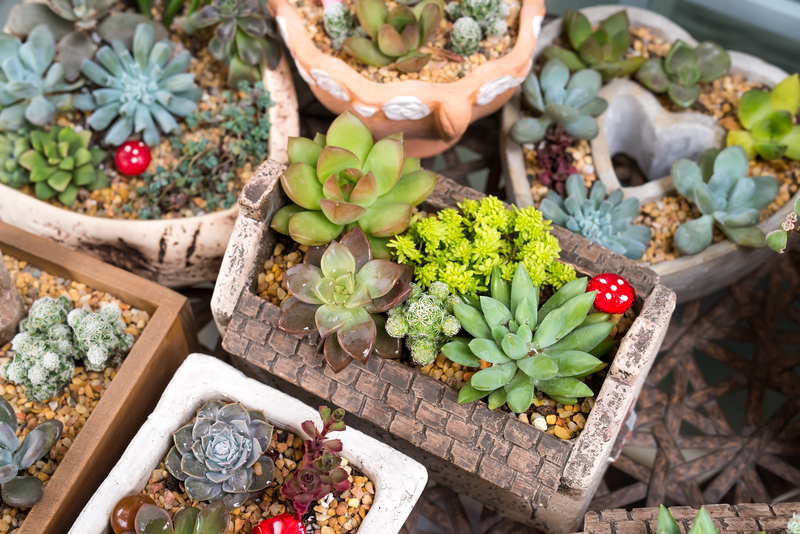Your Step-by-Step Guide to a Lush Herb Garden
Posted on 25/05/2025
Your Step-by-Step Guide to a Lush Herb Garden
Imagine stepping out your back door or onto your balcony and snipping fresh basil, rosemary, or mint for tonight's dinner. Not only do homegrown herbs add vibrant flavors to your meals, but they also bring beauty and a hint of luxury to your living space. Whether you're an experienced gardener or an enthusiastic beginner, cultivating a lush herb garden is both rewarding and surprisingly simple. In this comprehensive guide, we'll walk you through every stage, from selecting the perfect herbs to harvesting aromatic leaves for your kitchen.
Why Grow Your Own Herb Garden?
There are many compelling reasons to start your own herb garden:
- Fresh Flavors: Nothing compares to the taste of herbs picked minutes before use.
- Cost Savings: Growing herbs at home is much cheaper than buying supermarket packets.
- Health Benefits: Many herbs offer medicinal properties and are packed with antioxidants.
- Aesthetic Appeal: Herbs are visually pleasing, often with lush foliage and delicate flowers.
- Sustainability: Reduce food miles and plastic waste by growing your own.

Choosing the Best Location for Your Herb Garden
Indoors or Outdoors?
The first step towards a flourishing herb garden is to decide where you will grow your herbs. You can cultivate herbs indoors on a sunny windowsill or outdoors in a garden bed or containers. Consider the space available and the amount of sunlight your chosen location receives.
- Indoor Herb Gardens: Perfect for apartments and small spaces. Place pots near a south-facing window for optimal sunlight, and use grow lights if natural light is insufficient.
- Outdoor Herb Gardens: Best for a larger selection and more robust plants. Choose a spot that receives at least 6-8 hours of direct sunlight each day.
Soil Requirements
Your herbs' success depends on good soil. The ideal soil for a lush herb garden is well-draining, fertile, and light.
- Test your soil for pH (herbs thrive between 6.0-7.5).
- Add compost or organic matter to enrich texture and nutrients.
- Ensure proper drainage, especially for potted herbs. Add pebbles or sand if necessary.
Selecting the Right Herbs for Your Garden
Herb Varieties for Every Garden
To create a vibrant and diverse herb display, consider a mix of annuals, perennials, and biennials. Here are some favorites:
- Basil: Aromatic and versatile, essential for pesto and Mediterranean dishes.
- Mint: Refreshing flavor, perfect for teas and garnishes. Warning: Mint can spread rapidly--grow in containers to contain its growth!
- Rosemary: Woody and fragrant, suits roast dishes and breads. Drought-tolerant and easy to propagate.
- Thyme: Compact and flavorful, excellent in stews and as ground cover.
- Parsley: Biennial with bright, fresh taste; flat-leaf (Italian) or curly varieties.
- Cilantro/Coriander: Zesty leaves (cilantro) and flavorful seeds (coriander).
- Oregano: Mediterranean staple, great in sauces and pizza toppings.
- Sage: Pungent and robust, beautiful foliage, classic with poultry.
- Chives: Mild onion flavor, delicate purple flowers also edible.
Shopping for Seeds or Seedlings
You can start your herb garden from seed, nursery seedlings, or even cuttings from friends.
- Seeds: Cost-effective and offer many varieties, but require patience.
- Seedlings: Get a head start; ideal for beginners!
Step-by-Step Guide to Planting Your Lush Herb Garden
1. Planning Your Layout
Before you plant, decide whether you want a formal herb garden with geometric shapes or a relaxed, cottage-style patch. Group herbs with similar needs (like Mediterranean herbs: rosemary, thyme, oregano) together for easier care.
2. Planting Seeds or Seedlings
- Sow seeds according to packet instructions, usually 2-3 times deeper than the seed's diameter.
- Space plants adequately: Overcrowding reduces airflow and encourages disease.
- Gently water after planting to help roots settle in.
For container gardens: Use good-quality potting mix and choose pots with drainage holes.
3. Watering and Feeding
- Most herbs prefer even, consistent moisture. Water when the top inch of soil feels dry.
- Do not overwater! Soggy soil causes root rot. Mediterranean herbs prefer drier conditions.
- Feed monthly with diluted organic fertilizer or compost tea in the growing season.
4. Mulching and Weed Control
Mulch helps retain soil moisture, suppresses weeds, and regulates temperature.
- Use organic mulch such as straw, bark, or leaf mold.
- Keep mulch away from herb stems to prevent rot.
5. Pruning and Pinching for a Lush Herb Patch
- Pinch back tips of young herbs (like basil) to encourage bushier growth.
- Trim flowering stems (especially basil and mint) to prolong leaf production.
- Regular pruning keeps herbs tidy and productive.
Caring For Your Herb Garden: Tips for Success
Pest and Disease Management
Healthy herbs are less likely to suffer from pests and bugs, but stay vigilant for:
- Aphids: Can be removed with a strong water spray or soapy water.
- Snails and Slugs: Hand-pick or use natural deterrents like crushed eggshells.
- Powdery Mildew: Improve air circulation and avoid overhead watering.
Practice companion planting. For example, marigolds help repel certain pests from your herb beds.
Seasonal Care and Overwintering
Your herb garden will flourish with a little seasonal TLC.
- Annuals (like basil and cilantro) complete their lifecycle in one season. Reseed or replace as needed.
- Perennials (such as rosemary and sage) need light pruning as they grow. In cold climates, move tender perennials indoors or protect with mulch.
Container Herb Garden Tips
- Choose pots at least 6-8 inches deep.
- Group herbs by water and light needs (e.g., lavender, rosemary, and thyme together).
- Rotate containers for even sun exposure.
- Refresh soil and repot as needed to prevent overcrowding.
Harvesting: The Reward for Your Herb Garden Efforts
When and How to Harvest Herbs
- Best Time: Morning, after dew has dried but before the sun is too strong--this is when essential oils peak.
- Techniques: Use sharp scissors or snips, taking no more than a third of a plant at a time.
- Avoid letting herbs flower unless you want to save seeds; flowering often reduces flavor.
Storing and Preserving Your Herbs
- Fresh: Store cuttings in a jar of water on your counter for a few days.
- Drying: Tie small bundles and hang upside down in a dark, airy spot.
- Freezing: Chop and freeze in olive oil or water in ice cube trays.
This way, you can enjoy the taste of your lush herb garden all year round!
Design Ideas for a Beautiful Herb Garden
Herb Spiral
Create an eye-catching, space-efficient spiral of stacked stones or bricks. Plant drought-tolerant herbs on top and water lovers at the base.
Raised Beds and Vertical Gardens
- Build raised beds for easy access, better drainage, and defined borders.
- Install a vertical herb garden on fences or walls to save space and add greenery to small yards or balconies.
Companion Planting in Your Herb Patch
- Pair herbs with vegetables to deter pests (e.g., basil with tomatoes, dill with cabbage).
- Mix edible flowers such as nasturtiums for a truly lush look.

Common Mistakes to Avoid in Your Herb Garden
- Overwatering--herbs prefer slightly dry to moderately moist soil. Too much water suffocates roots.
- Planting shade-loving and sun-loving herbs together.
- Ignoring regular harvesting--frequent snipping encourages fresh growth!
- Using poor quality or compacted soil.
- Overcrowding plants, reducing air flow and light penetration.
Your Lush Herb Garden: A Source of Flavor and Joy
Growing your own lush herb garden gives you a supply of aromatic, healthful, and delicious leaves on demand. From pots on a windowsill to a sprawling backyard patch, herbs are among the easiest and most rewarding plants to cultivate. Just follow these step-by-step tips: choose a sunny spot, start with quality soil, select herbs suited to your climate and tastes, and provide consistent care. In no time, you'll enjoy the bounty and beauty of homegrown herbs--ready to invigorate your cooking, delight your senses, and decorate your space.
Start Your Herb Garden Today!
With patience, observation, and a bit of creativity, anyone can create a thriving, lush herb garden. Start small or dream big--the next flavorful harvest could be right outside your door. Happy gardening!

